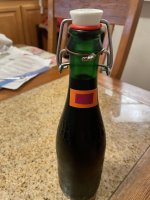tyrub42
Well-Known Member
- Joined
- Oct 13, 2016
- Messages
- 330
- Reaction score
- 139
Hi everyone,
I'm living in an apartment where the ambient summer temp gets up to around 95f/34c. I've had a sour going that's currently at 7 months and I'm wondering if y'all think I'm safe to bottle it now. Here's all the important info:
-Sour red ale with mulberries added
-Mulberries have been in the fermenter for 5 weeks so far and I'm about to take them out
-Yeast is Roeselare gen 1 plus Lindemann's and Boon dregs
-OG: 1.055
-FG: 1.004 (been 1.004 for 2 months so far but maybe the mulberries make that less reliable?)
-current age: 7 months
-temp range (approximate): 65 for the first two months, then 75 for the second two months, 85ish for the next 1.5, and 90ish for the last 1.5
My plan as of now is to bottle them and prime the bottles for low carbonation of about 2vol, in case it moves down another point or two. I figure I don't mind lower carbonation on a sour, and the bottles I'm using are thicker than standard bottles (about halfway between a standard American bottle and an Orval bottle).
The reason I'm keen to bottle is that I can store them at a friend's place around 75 once they are bottled, which I think would be better for the beer.
Do you think this seems like a safe plan? This way I'm basically happy and safe if the beer stats at it's current gravity, and stay safe even if it goes down another 2 points.
There are two other backup plans as well:
-plan b: add Ultra Ferm a week before bottling. Safer but I feel like it could have a negative effect on flavor?
-plan c: take out the mulberries and leave the fermenter in 95 degrees for another 3 months to be safer. But I can't help but think it'll be bad for the beer to sit so hot for so long, and it would take away lots of mulberry freshness.
Anyway, sorry for the long thread, but thought I'd see what everyone thought.
Thanks!
Tyler
I'm living in an apartment where the ambient summer temp gets up to around 95f/34c. I've had a sour going that's currently at 7 months and I'm wondering if y'all think I'm safe to bottle it now. Here's all the important info:
-Sour red ale with mulberries added
-Mulberries have been in the fermenter for 5 weeks so far and I'm about to take them out
-Yeast is Roeselare gen 1 plus Lindemann's and Boon dregs
-OG: 1.055
-FG: 1.004 (been 1.004 for 2 months so far but maybe the mulberries make that less reliable?)
-current age: 7 months
-temp range (approximate): 65 for the first two months, then 75 for the second two months, 85ish for the next 1.5, and 90ish for the last 1.5
My plan as of now is to bottle them and prime the bottles for low carbonation of about 2vol, in case it moves down another point or two. I figure I don't mind lower carbonation on a sour, and the bottles I'm using are thicker than standard bottles (about halfway between a standard American bottle and an Orval bottle).
The reason I'm keen to bottle is that I can store them at a friend's place around 75 once they are bottled, which I think would be better for the beer.
Do you think this seems like a safe plan? This way I'm basically happy and safe if the beer stats at it's current gravity, and stay safe even if it goes down another 2 points.
There are two other backup plans as well:
-plan b: add Ultra Ferm a week before bottling. Safer but I feel like it could have a negative effect on flavor?
-plan c: take out the mulberries and leave the fermenter in 95 degrees for another 3 months to be safer. But I can't help but think it'll be bad for the beer to sit so hot for so long, and it would take away lots of mulberry freshness.
Anyway, sorry for the long thread, but thought I'd see what everyone thought.
Thanks!
Tyler
















![Craft A Brew - Safale BE-256 Yeast - Fermentis - Belgian Ale Dry Yeast - For Belgian & Strong Ales - Ingredients for Home Brewing - Beer Making Supplies - [3 Pack]](https://m.media-amazon.com/images/I/51bcKEwQmWL._SL500_.jpg)























